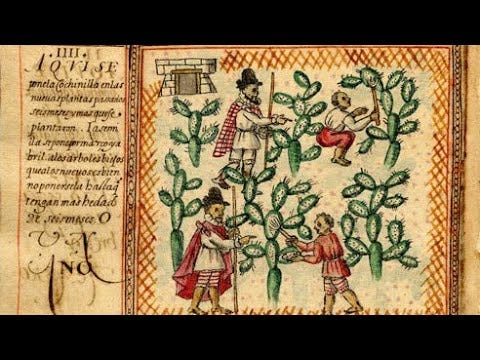When I revived my newsletter using Substack, I thought of it primarily as a way to sent out my recent work to people who don’t follow me on Facebook or Twitter. Then I started adding old articles relevant to current discussions. I'm now sending out two newsletters a week: one with updates and one with something from the archives.
I quickly learned that Substack offers a distinct advantage over both social media and ordinary publication: I can add new material that doesn’t fit easily into a normal article, often because it’s simply too long. If you read the newsletter, you get to see things like the 1799 poem about giving a young sailor a pocket globe or my great-grandfather writing in 1928 about the early days of mechanical cotton harvesting.
One happy result of the newsletter has been an invitation from Steven Heller and Debbie Millman to publish in their revitalized online version of Print Magazine, starting with this reprint of an article on summertime textiles that I wrote last summer for Zocálo:
Wedding dresses and bridal veils. Graduation caps and gowns. The Stars and Stripes and the rainbow Pride flag. Rally towels and baseball caps. The flags and fashions of the Olympic opening ceremonies. Checked picnic blankets and striped beach towels. The red, green, and black of Juneteenth celebrations.
Summer wouldn’t be summer without textiles.
Blessed with an abundance of cloth, we tend to take textiles for granted, all the more so when we aren’t bundled up against the cold. But textiles are among the oldest, most essential, and most pervasive of human inventions. Their summertime incarnations demonstrate just how central they are to defining who we are. Freed by higher temperatures from most of their protective functions, in the summer textiles reveal their social side, becoming signs of who we are and what we value.
This article also answers a question I’m often asked but don’t address in The Fabric of Civilization: When did wearing clothes start? Read the whole thing here.
Writing timely yet timeless columns
As a Bloomberg Opinion columnist, I have a strong incentive to tie my articles to the news. But as a writer (and reader) with little patience for boredom and repetition, I strive to offer unique material—writing on topics, or offering perspectives, that you won’t get from other people. It’s hard to say something new on a subject that everyone is writing about. To square the circle, I often address cultural, historical, or philosophical themes using recent news as a springboard.
One of my most popular recent articles was this one from a year ago, inspired by the news that the large jeweler Pandora would no longer use mined diamonds in its wares. Titled “‘Natural’ and ‘Ethical’ Are Getting a Divorce,” it allowed me to tap files about synthetic luxuries that I’ve been collecting for years, while drawing on themes about nature and artifice of perennial interest. Here’s the lead:
Vegan silk and leather, mine-free diamonds, bioengineered perfumes: Lab-grown products with ethical appeal could be the future of luxury. Exemplified by the announcement last week that giant jeweler Pandora A/S will no longer use mined diamonds in its products, the emergence of these high-tech luxury goods represents a significant cultural shift.
Since the first Earth Day a half-century ago, large industries have grown from the widespread conviction that “natural” foods, fibers, cosmetics and other products are better for people and the planet. It’s an attitude that dates back to the 18th- and 19th-century Romantics, who rejected industrialism in favor of sublime landscapes and rural nostalgia: What’s given is good; what’s made is suspicious, especially if it’s of recent origin.
That assumption is beginning to reverse, as entrepreneurs and consumers turn to cutting-edge artifice in search of more environmentally friendly, less ethically fraught materials. Substances grown in fermentation vats or built up atom by atom are replacing those wrenched from the earth, stripped from plants and animals or implicated in human suffering.
You can read the whole thing here. It inspired a panel at South by Southwest and I expect to do further reporting on the topic this summer.
This past week, the death of paparazzo Ron Galella, best known for his photos of Jackie Kennedy Onassis, inspired a column on celebrity photography, drawing on history I learned while researching The Power of Glamour:
Ron Galella, the New York paparazzo best known for his stealth photos of Jacqueline Kennedy Onassis, died last Saturday. Born in 1931, Galella lived through three culturally and technologically distinct eras in celebrity photography. Despite their enormous differences in ethos and aesthetics, their common elements offer insights into our photo-saturated age.
The full version, including links and good examples of photos, is at Bloomberg Opinion here, but the Washington Post ran a link-free version that my subscription allows an ungated link to here. (Bloomberg allows a limited number of free reads a month.)
Misc. book news
The History in Story newsletter ran a nice review of The Fabric of Civilization, accompanied by an excellent teaser Twitter thread, featuring interesting examples from the book.
Apple is running a sale on the audio version of The Fabric of Civilization. It’s $4.99 through May 18. You’ll find it in Buzzy Nonfiction under History here.
Subscribe to my YouTube channel
It will encourage me to make more videos like this one.




I see similar results. Having been writing blog posts since 2004, I see two benefits to writing at Substack. One is rework older pieces on leadership for a new and very different context. The second is to find a new audience who are looking for more in depth, longer pieces. BTW, I’m writing on The Future of Leadership at edbrenegar.Substack.com.